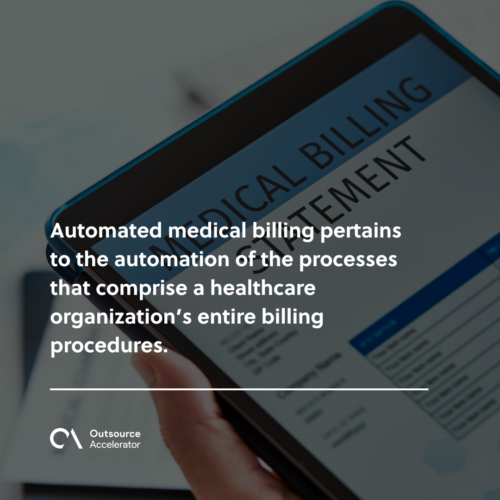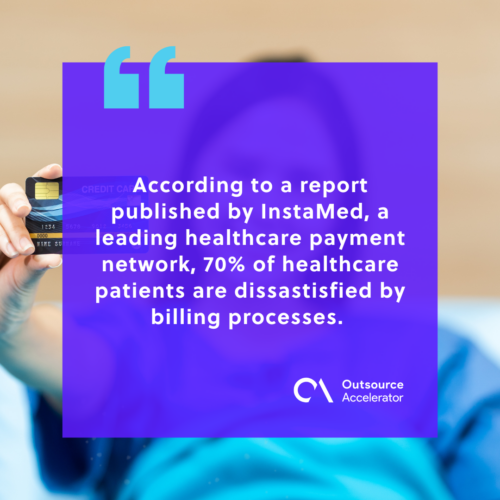Top 5 reasons why automated medical billing is a must for healthcare providers

The medical billing process is an essential aspect of the healthcare industry. It is a long and complex process that often requires the involvement of most of a healthcare facility’s departments.
The involvement of multiple departments and point persons (e.g., billing department, administrative department, and clinicians) within a healthcare organization makes it tedious and prone to overlaps.
Healthcare providers can easily circumvent these errors by adopting an automated medical billing system instead of doing it manually.
Besides being prone to human error, manually processing medical billing can negatively affect a healthcare organization’s productivity and bottom line.
Thus, adopting medical billing automation processes will not only help healthcare providers reduce errors but also help the industry save billions of dollars annually.
What is automated medical billing?
Automated medical billing pertains to the automation of the processes that comprise a healthcare organization’s entire billing procedures.
Adopting an automated medical billing system lets healthcare providers process insurance claims more quickly than manually going through the course.
Automated processes[1] also make healthcare providers aware of errors before submitting the claims to a patient’s payers.
In short, health service providers that automate medical billing effectively do more with less.
Automating a healthcare provider’s billing process requires the use of specialized billing software tools, which we’ll discuss in a later section.

Which parts of the medical billing process can be automated?
The medical billing process is comprised of various other procedures, many of which are repetitive.
Below are some automatable parts of the medical billing process:
Appointment scheduling
In automated appointment scheduling, robotic process automation (RPA) bots handle the end-to-end scheduling process. This process includes initial registration up to the completion of a visit or consultation.
HIPAA compliance
An automated medical billing process also makes compliance with the Health Insurance Portability and Accountability Act (HIPAA)[2] easier.
With a largely RPA-implemented workflow, healthcare providers won’t have to worry about errors and omissions in their procedures.
Revenue cycle management
Revenue cycle management (RCM) is arguably the most important part of an automated medical billing process.
An efficient and automated RCM translates to faster tracking, identification, collection, and management of incoming payments.
Claims processing
Automation also makes keeping up-to-date fee schedules, remittance, and claims tracking more efficient and manageable. Letting RPA bots handle the repetitive and more error-prone parts of claims management reduces the chances of having unpaid or underpaid claims.
Top 5 reasons why healthcare providers need automated medical billing
As with other industries, automation solutions make healthcare providers’ procedures much more efficient and less prone to human error.
Aside from having more streamlined procedures, there are many other benefits that businesses in the health sector can gain by adopting an automated medical billing process.
Below are some of these advantages:
1. Automated medical billing saves time and money
As mentioned earlier, an automated billing system helps health service providers make their processes streamlined and more efficient.
Healthcare organizations seeking to implement or optimize these solutions can partner with specialized firms like Acquire Intelligence, which leverages AI to transform medical and clinical processes.
In turn, an automated healthcare billing system reduces the need for manual data entry and follow-up on claims, saving staff time and reducing errors.
Additionally, automated billing systems can flag denied claims for review, reducing the need for expensive appeals.
2. Automated medical billing improves documentation
Automating processes gives healthcare providers a more accurate and efficient way of recording and storing patient information.
As data are captured electronically, automation removes the need for manual data entry and significantly reduces the chances of document mishandling.
Moreover, healthcare providers can integrate their automated medical billing software with other health information systems.
3. Automated medical billing improves productivity
An indirect (but still welcome) effect of automating any business process is the improved level of productivity. The same applies to the healthcare industry.
Automation frees up a healthcare organization’s human resources from repetitive and often mundane tasks. This allows them to focus on more engaging (and often revenue-generating) aspects of their jobs, such as providing patient care.
4. Automated medical billing gives healthcare providers better insights
The automated medical billing software that healthcare providers use often comes with report and analytics capabilities.
It helps them quantify and improve their overall performance and efficiency through actionable insights from various metrics.
Aside from this, it also allows them to link billing information with existing accounting systems. Doing so gives healthcare providers valuable financial insights, such as where they can add more profitability and which parts of their business cause the biggest losses.
5. Automated medical billing improves patient satisfaction
According to a report published by InstaMed, a leading healthcare payment network, 70% of healthcare patients are dissatisfied with billing processes. The report also showed that 72% of healthcare consumers are confused by the explanation of their benefits.
Using automated billing processes can help health service providers give patients more detailed information regarding their medical bills and payment options.
It also lets patients access payment plans and manage payment from multiple channels, keeping the payment process easy to understand for them.

Software tools that can help with automated medical billing
Healthcare providers have plenty of options to choose from when it comes to automating their processes.
Automation software have varying benefits, capabilities, and ideal use (e.g., best used by small businesses, works best with behavioral therapy practitioners, or is recommended for large enterprises).
Some of the best software currently in the market are:
References
[2] compliance with HIPAA. Vazquez, J. et al. (2021). “Access to care matters: Remote healthcare needs during COVID-19.” Telemedicine and E-health, 27(4), pp. 468-471. https://doi.org/10.1089/tmj.2020.0371







 Independent
Independent




